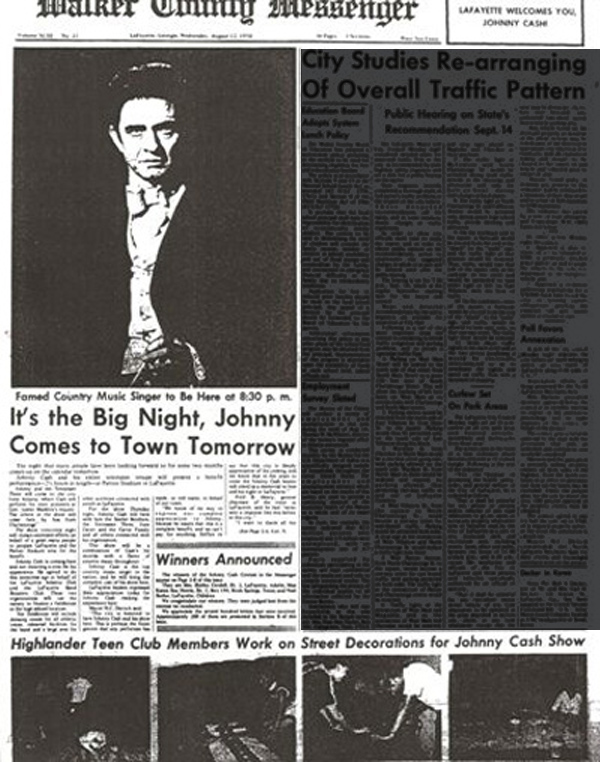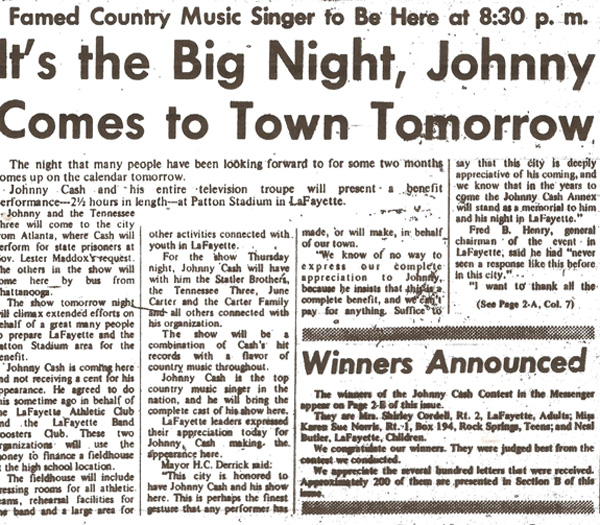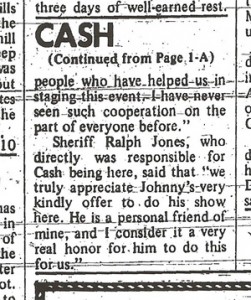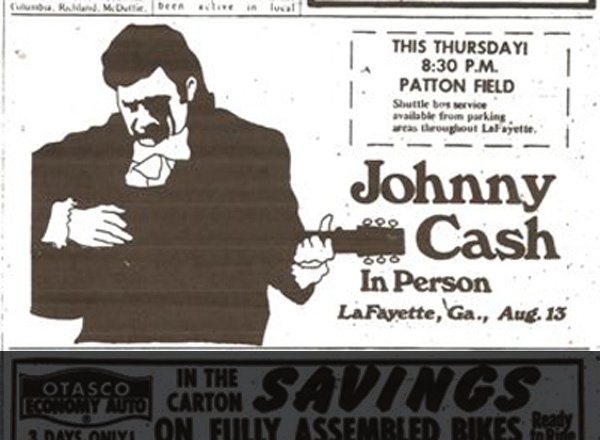08.24
Johnny Cash got most of the August 12th Walker County Messenger front page, and the paper was filled with news about concert preparation and winners of a show-related contest. The paper also had a special Cash section, which we’ll discuss in a bit. First, a closer look at the front page:
LaFayette’s Johnny Cash Show required a lot of work, planning, and cooperation. Sheriff Jones got the singer’s commitment, insurance salesman and civic-leader Fred Henry organized the event, members of the Athletic Club and Band Boosters volunteered in various ways, and elected leaders lent their support. Even high school students contributed to decorate the streets and set up the football field. Work and cooperation from almost everyone in the community was necessary to carry out such a massive event. It’s impossible to think of anything of that scale being carried out in LaFayette today when city leaders hardly seem competent enough to assemble a good-sized birthday party.
Johnny Cash himself also had to put in effort to make the concert happen, along with his band and manager, the other performers, and many behind-the-scenes people. Many were paid through Cash, but there was no evident profit motive for anyone involved on either side of the event – simply a desire to help a small town build something nice for its youth. In this day the thought of that is absolutely refreshing.
Bobby Edwards, the deputy who refused a bribe from Johnny Cash, is now 69, retired, and living in the area. Sheriff Jones served as Walker County’s top law enforcement official for fourteen more years, finally retiring in 1984 after a record-setting two decades as Sheriff. Jones passed away in 2006. Fred Henry spent his life selling insurance but also founded the Downtown Development Authority, LaFayette Development Authority, and LaFayette Chamber of Commerce (now merged into the county chamber); got Queen City Lake built; doubled the size of LaFayette Golf Course; and played a key role in bringing Roper and BlueBird into town. He passed away in 2008 and has a short driveway near the golf course named after him.
Of course those men weren’t perfect, and some of their altruistic activities also benefitted themselves – Fred Henry’s property around Queen City Lake became much more valuable after the lake was built, and Sheriff Jones never wasted an opportunity to remind voters about his connection to Cash (“He is a personal friend of mine…”). But overall Henry, the Sheriff, businessman Ross Abney, several of the older Gilberts, and others involved in the LaFayette Athletic Club or various other civic clubs and development groups left the city in better shape when their lives ended than it was when their lives began. That’s something that can’t be said about most in leadership here today.
Johnny Cash and June Carter both went on to Glory in 2003. The other members of June’s family music group, the Carter Sisters, have also passed away. Johnny’s long-time road manager and original bassist Marshall Grant, who played a big role in organizing the LaFayette show, died two weeks ago. Guest guitarist Carl Perkins, who wrote the well-known song “Blue Suede Shoes”, passed in 1998.
Three of the four Statler Brothers are still alive, retired since 2002, as are Tennessee Three guitarist Bob Wootton and drummer W. S. “Fluke” Holland. Wootton and Holland still occasionally tour and perform as part of a reconstituted Tennessee Three, minus (of course) Cash and Grant.
<---PREVIOUS PAGE / PAGE 2 OF 6 / 1 2 3 4 5 6 / NEXT PAGE —>















If you’re reading this comment without checking out all six pages of the blog post, go read them. This is the first article in LU’s two year history that was long enough to require multiple pages. I hope that makes it easier to read. If the format or navigation give you any trouble please let us know.
Now, to clarify and explain a few things about the article…
We had originally hoped to get this done LAST year on the concert’s 40th anniversary, but due to other pressing issues and some research problems it wasn’t possible in 2010. We did get something up last year ( http://www.cityoflafayettega.com/2010/08/the-man-in-black/) but not the article originally planned. This year’s piece wasn’t done on August 13th either, but close enough to post. Apologies for not having it finished on time, this site is a bit of a side job for some of us and other things have to take priority.
Most of the research problems we had were due to a total lack of cooperation at the Walker County Messenger office. A now-former employee of the WCM assured us that their archives were available by request, with over 100 years of old papers in a filing cabinet easily accessible in their office. But when we sent a researcher to their office another employee there was anything but helpful. Our poor volunteer was given a runaround, treated hatefully, and told that the papers we wanted were “in the old building” and inaccessible.
The researcher finally resorted to using the LaFayette library where employees were both friendly and helpful. They found a folder of printouts from microfiche archives of the Messenger and got copies of those to scan. Those scanned copied printouts are the black and white images used in this article. Unfortunately they were originally archived in a format that doesn’t retain gray tones, which is why the photos look so terrible. If you have any better versions of the images used please let us know and we’ll gladly replace them. Also feel free to add information (or corrections) about the events and people mentioned.
Color newspaper images (and some facts) included came from last January’s Messenger article about the city’s stadium renovation plans – http://www.catwalkchatt.com/view/full_story/11045408/article-Renovation-plans-for-old-LaFayette-High-stadium-has-people-remembering-Cash-benefit-from-1970? . Those inaccessible archives apparently became accessible again when it was for their own purposes (which is fair, it’s their own stuff) – but that article wouldn’t have surfaced either, without our original article last June reminding people that the football field still exists and has been neglected.
Thanks to researcher VS for all the hard work in tracking down the archived documents and putting up with harassment from people who should have better manners.
— LU
I am really glad that you guys decided to make this post this year, it was VERY well written and explained a lot about a piece of La Fayette history I have been very interested in for some time, but could never find much information about myself. I sincerely hope that the city does take steps towards fixing up this stadium, and it saddens me that it took them this long to see the fact that this stadium could be so useful. I booked concerts through the Recreation Center in the building right above the field and every time I would walk outside and look at the field and wish that I could have the concerts out there and set up some other events that aren’t centered around just one group of people. If they begin to take volunteers to help do the work though, I will most definitely sign up, and get as many people I know to do so also. We need to work together to better this community if we are to make any progress. Thank you LU, and keep doing what you’re doing!